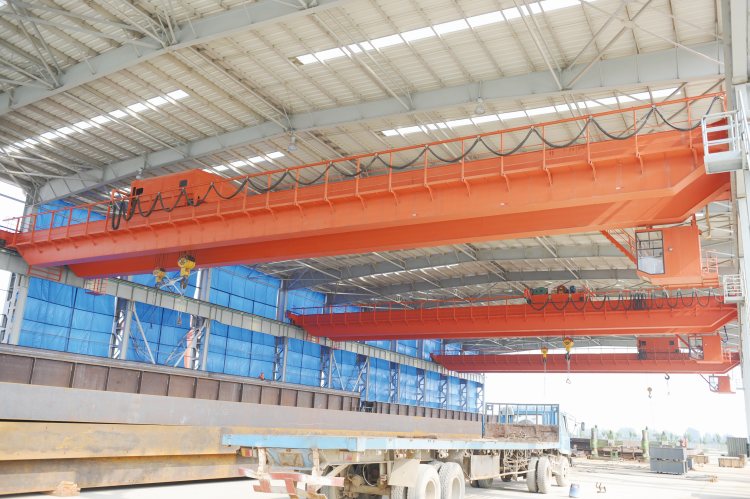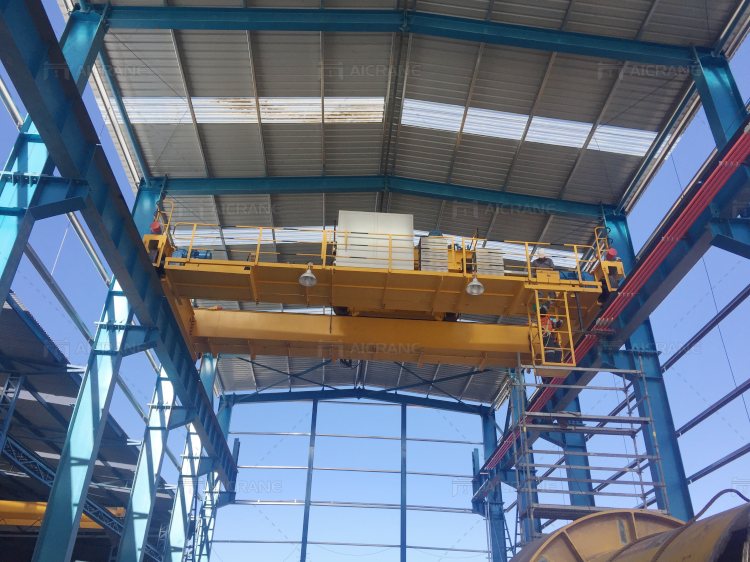Overhead cranes, particularly those with a capacity of 50 tons, are indispensable in various industrial applications due to their ability to lift and transport heavy loads efficiently. While their operational benefits are clear, it is also crucial to consider their environmental impact. In the context of growing environmental awareness and stricter regulations, companies need to address the ecological footprint of their operations, including the use of heavy machinery like 50 ton overhead cranes. This article explores the environmental considerations associated with using 50 ton overhead crane and provides insights into how companies can mitigate their environmental impact.

Energy Consumption
Electricity Use: The operation of a 50 ton overhead crane typically requires a significant amount of electrical energy. The primary energy consumption comes from the motors used for lifting, traveling, and hoisting. Depending on the frequency and duration of use, the electricity consumption can contribute substantially to a facility’s overall energy use.
Reducing Energy Consumption: To minimize energy consumption, companies can adopt several strategies:
Energy-efficient Motors: Using high-efficiency motors can reduce energy consumption by up to 30%.
Variable Frequency Drives (VFDs): VFDs allow for better control of motor speed and torque, reducing energy use during low-load operations.
Regenerative Braking: This technology recovers energy during braking and feeds it back into the power system, reducing overall energy consumption.
Emissions and Carbon Footprint
Indirect Emissions: While 50-ton overhead cranes do not produce direct emissions, their operation indirectly contributes to carbon emissions through the electricity they consume. The source of this electricity significantly impacts the crane’s carbon footprint. For example, electricity generated from fossil fuels has a higher carbon footprint compared to renewable energy sources.
Reducing Carbon Footprint: Companies can reduce the carbon footprint of their 50 ton overhead crane systems by:
Renewable Energy: Sourcing electricity from renewable energy providers or installing on-site renewable energy systems such as solar panels.
Energy Management Systems: Implementing systems to monitor and manage energy use more effectively, identifying areas for improvement and optimizing overall energy consumption.

Noise Pollution
Operational Noise: Large overhead cranes can generate considerable noise during operation, primarily from motors, gearboxes, and other moving parts. Noise pollution is a concern, especially in urban or densely populated areas, and can impact the health and well-being of workers and nearby residents.
Noise Mitigation: To mitigate noise pollution, companies can:
Regular Maintenance: Ensuring that all parts are well-lubricated and maintained to minimize noise.
Soundproofing: Installing soundproofing materials around the crane and in the facility to absorb and reduce noise levels.
Quiet Operation Modes: Utilizing cranes with quieter operational modes or components designed to produce less noise.
Material and Resource Use
Construction and Manufacturing: The construction and manufacturing of 50 ton overhead lifting crane solutions require substantial amounts of steel and other materials, which have their own environmental impacts. The extraction, processing, and transportation of these materials contribute to resource depletion and environmental degradation.
Sustainable Materials: Companies can mitigate the environmental impact by:
Recycled Materials: Using recycled steel and other materials in the construction of the cranes.
Sustainable Sourcing: Ensuring that materials are sourced from suppliers who adhere to sustainable practices and environmental standards.
Waste Management
Operational Waste: The operation and maintenance of 50 ton overhead cranes generate waste, including used lubricants, worn-out parts, and packaging materials. Proper waste management is essential to minimize environmental impact.
Waste Reduction Strategies: To reduce waste, companies can implement the following strategies:
Recycling Programs: Establishing recycling programs for used lubricants, metals, and other materials.
Extended Lifespan: Using high-quality components and performing regular maintenance to extend the lifespan of parts and reduce the frequency of replacements.
Proper Disposal: Ensuring that hazardous materials are disposed of properly in accordance with environmental regulations.
Environmental Regulations and Compliance
Regulatory Requirements: The use of 50 ton overhead cranes is subject to various environmental regulations that aim to minimize their impact. Compliance with these regulations is not only a legal requirement but also a critical component of sustainable operations.
Compliance Strategies: To ensure compliance, companies can:
Regular Audits: Conducting regular environmental audits to identify and address potential areas of non-compliance.
Training: Providing training to operators and maintenance personnel on environmental best practices and regulatory requirements.
Environmental Management Systems: Implementing comprehensive environmental management systems to monitor and manage the environmental impact of crane operations.
Technological Advancements and Innovations
Green Technologies: Advancements in technology offer new opportunities to reduce the environmental impact of 50ton overhead cranes. Innovations such as hybrid systems, advanced monitoring tools, and automation can significantly enhance the efficiency and sustainability of crane operations.
Adoption of Innovations: Companies should stay abreast of technological developments and consider integrating the following innovations:
Hybrid Systems: Combining electric and hydraulic systems to optimize energy use and reduce emissions.
Advanced Monitoring Tools: Using IoT and smart sensors to monitor energy consumption and operational efficiency in real-time, enabling proactive adjustments and improvements.
Automation: Implementing automated systems to optimize crane operations, reduce human error, and improve overall efficiency.
The use of 50 ton overhead cranes, while essential for many industrial applications, comes with significant environmental considerations. By addressing energy consumption, emissions, noise pollution, material use, waste management, and regulatory compliance, companies can significantly reduce the environmental impact of their crane operations. Embracing technological advancements and sustainable practices not only helps protect the environment but also enhances operational efficiency and long-term profitability. As environmental awareness and regulations continue to evolve, adopting proactive measures to mitigate environmental impact will become increasingly important for businesses relying on heavy duty cranes.